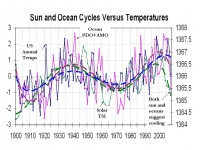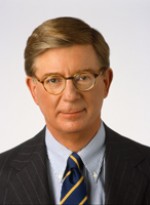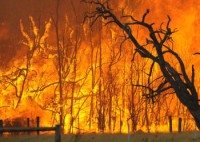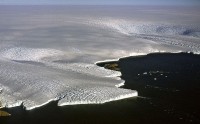Mar 03, 2009
Global Warming On Hold
By Michael Reilly, Discovery News
For those who have endured this winter’s frigid temperatures and today’s heavy snowstorm in the Northeast, the concept of global warming may seem, well, almost wishful. But climate is known to be variable—a cold winter, or a few strung together doesn’t mean the planet is cooling. Still, according to a new study, global warming may have hit a speed bump and could go into hiding for decades.
Earth’s climate continues to confound scientists. Following a 30-year trend of warming, global temperatures have flatlined since 2001 despite rising greenhouse gas concentrations, and a heat surplus that should have cranked up the planetary thermostat.
For those who have endured this winter’s frigid temperatures and today’s heavy snowstorm in the Northeast, the concept of global warming may seem, well, almost wishful. But climate is known to be variable—a cold winter, or a few strung together doesn’t mean the planet is cooling. Still, according to a new study, global warming may have hit a speed bump and could go into hiding for decades.
Earth’s climate continues to confound scientists. Following a 30-year trend of warming, global temperatures have flatlined since 2001 despite rising greenhouse gas concentrations, and a heat surplus that should have cranked up the planetary thermostat. For those who have endured this winter’s frigid temperatures and today’s heavy snowstorm in the Northeast, the concept of global warming may seem, well, almost wishful.
But climate is known to be variable—a cold winter, or a few strung together doesn’t mean the planet is cooling. Still, according to a new study, global warming may have hit a speed bump and could go into hiding for decades. Earth’s climate continues to confound scientists. Following a 30-year trend of warming, global temperatures have flatlined since 2001 despite rising greenhouse gas concentrations, and a heat surplus that should have cranked up the planetary thermostat.
“This is nothing like anything we’ve seen since 1950,” Kyle Swanson of the University of Wisconsin-Milwaukee said. “Cooling events since then had firm causes, like eruptions or large-magnitude La Ninas. This current cooling doesn’t have one.”
Instead, Swanson and colleague Anastasios Tsonis think a series of climate processes have aligned, conspiring to chill the climate. In 1997 and 1998, the tropical Pacific Ocean warmed rapidly in what Swanson called a “super El Nino event.” It sent a shock wave through the oceans and atmosphere, jarring their circulation patterns into unison.
How does this square with temperature records from 2005-2007, by some measurements among the warmest years on record? When added up with the other four years since 2001, Swanson said the overall trend is flat, even though temperatures should have gone up by 0.2 degrees Centigrade (0.36 degrees Fahrenheit) during that time.
The discrepancy gets to the heart of one of the toughest problems in climate science—identifying the difference between natural variability (like the occasional March snowstorm) from human-induced change.
But just what’s causing the cooling is a mystery. Sinking water currents in the north Atlantic Ocean could be sucking heat down into the depths. Or an overabundance of tropical clouds may be reflecting more of the sun’s energy than usual back out into space.
Swanson thinks the trend could continue for up to 30 years. But he warned that it’s just a hiccup, and that humans’ penchant for spewing greenhouse gases will certainly come back to haunt us. “When the climate kicks back out of this state, we’ll have explosive warming,” Swanson said. “Thirty years of greenhouse gas radiative forcing will still be there and then bang, the warming will return and be very aggressive.” Read story here.

See larger image here.
Swanson had it right up to the last paragraph. The warming and cooling relates to the cyclical nature of the oceans (and sun). The Pacific and recently the Atlantic went into strong cooling the last few years, taking surface temperatures down with them. In 30 years, they will bounce back and temperatures will do also. CO2 plays no role.
Mar 01, 2009
Clear Thinking on Global Warming
By Randall Hoven in the American Thinker
Many people write sensible things about anthropogenic global warming, but I find Professor William Happer’s statement to the US Senate on February 25, 2009, especially clear and convincing. Happer is the Cyrus Fogg Bracket Professor of Physics at Princeton University. He was also the Director of Energy Research at DOE from 1990-93, where he supervised all of DOE’s work on climate change.
He says this:"The climate is warming and CO2 is increasing. Doesn’t this prove that CO2 is causing global warming through the greenhouse effect? No, the current warming period began about 1800 at the end of the little ice age, long before there was an appreciable increase of CO2. There have been similar and even larger warmings several times in the 10,000 years since the end of the last ice age. These earlier warmings clearly had nothing to do with the combustion of fossil fuels. The current warming also seems to be due mostly to natural causes, not to increasing levels of carbon dioxide. Over the past ten years there has been no global warming, and in fact a slight cooling. This is not at all what was predicted by the IPCC models.
“He explains the “bit player” role that CO2 plays in greenhouse warming. Even if doubled, CO2 in the atmosphere would increase global temperatures “on the order of one degree,” all else equal, and that would be about as much as it could ever increase it. He explains that not all else is equal. He explains that satellite measurements indicate that water vapor and clouds, which account for 90% of greenhouse warming, have a negative feedback with CO2 levels, thus counteracting most or all of the warming effects of CO2. He explains that temperatures have been warmer in the past and undergo cycles, counter to the “hockey stick” graph trumpeted in the third report of the IPCC.
The hockey stick “was the result of incorrect handling of proxy temperature records and incorrect statistical analysis. There really was a little ice age and there really was a medieval warm period that was as warm or warmer than today. I bring up the hockey stick as a particularly clear example that the IPCC summaries for policy makers are not dispassionate statements of the facts of climate change.” He explains how ice core observations show that historical temperatures and CO2 levels are indeed correlated, but that temperature increases preceded the CO2 increases - by “about 800 years”, thus indicating that warming causes increased CO2 and not vice versa.
He explains how erroneous computer models are."It is true that climate models use increasingly capable and increasingly expensive computers. But their predictions have not been very good. For example, none of them predicted the lack of warming that we have experienced during the past ten years. All the models assume the water feedback is positive, while satellite observations suggest that the feedback is zero or negative.”
On sea level rise, “The sea level is indeed rising, just as it has for the past 20,000 years since the end of the last ice age. Fairly accurate measurements of sea level have been available since about 1800. These measurements show no sign of any acceleration."He explains that CO2, and higher concentrations of it in the atmosphere, are actually good for us. “Crop yields will continue to increase as CO2 levels go up, moderate warming is an overall benefit to mankind because of higher agricultural yields and many other reasons.”
And finally, he shoots down the supposed “scientific consensus” on global warming. For one, consensus is not the way science works. And two, there is no consensus.His statement is truly scientific. Not because he is a credentialed scientist, but because he uses physical observations to support or falsify hypotheses. Unlike so many other statements on climate change (e.g., any statement from Al Gore or NASA’s James Hansen), you can follow his reasoning and it makes sense.Keep his testimony in your hip pocket, for the next time you are called a “denier.” Read story here. Read Happer’s submitted testimony here.
Feb 27, 2009
Climate Science in A Tornado
By George Will, Washington Post
Icecap Note: Before reading George’s rebuttal, see this right on Watts Up with That perspective. Here is George’s Post.
Few phenomena generate as much heat as disputes about current orthodoxies concerning global warming. This column recently reported and commented on some developments pertinent to the debate about whether global warming is occurring and what can and should be done. That column, which expressed skepticism about some emphatic proclamations by the alarmed, took a stroll down memory lane, through the debris of 1970s predictions about the near certainty of calamitous global cooling.
Concerning those predictions, the New York Times was—as it is today in a contrary crusade—a megaphone for the alarmed, as when (May 21, 1975) it reported that “a major cooling of the climate” was “widely considered inevitable” because it was “well established” that the Northern Hemisphere’s climate “has been getting cooler since about 1950.” Now the Times, a trumpet that never sounds retreat in today’s war against warming, has afforded this column an opportunity to revisit another facet of this subject—meretricious journalism in the service of dubious certitudes.
On Wednesday, the Times carried a “news analysis”—a story in the paper’s news section, but one that was not just reporting news—accusing Al Gore and this columnist of inaccuracies. Gore can speak for himself. So can this columnist.

Reporter Andrew Revkin’s story was headlined: “In Debate on Climate Change, Exaggeration Is a Common Pitfall.” Regarding exaggeration, the Times knows whereof it speaks, especially when it revisits, if it ever does, its reporting on the global cooling scare of the 1970s, and its reporting and editorializing—sometimes a distinction without a difference—concerning today’s climate controversies.
Which returns us to Revkin. In a story ostensibly about journalism, he simply asserts—how does he know this?—that the last decade, which passed without warming, was just “a pause in warming.” His attempt to contact this writer was an e-mail sent at 5:47 p.m., a few hours before the Times began printing his story, which was not so time-sensitive—it concerned controversies already many days running—that it had to appear the next day. But Revkin reported that “experts said” this columnist’s intervention in the climate debate was “riddled with” inaccuracies. Revkin’s supposed experts might exist and might have expertise but they do not have names that Revkin wished to divulge. As for the anonymous scientists’ unspecified claims about the column’s supposedly myriad inaccuracies: The column contained many factual assertions but only one has been challenged. The challenge is mistaken.
Citing data from the University of Illinois’ Arctic Climate Research Center, as interpreted on Jan. 1 by Daily Tech, a technology and science news blog, the column said that since September “the increase in sea ice has been the fastest change, either up or down, since 1979, when satellite record-keeping began.” According to the center, global sea ice levels at the end of 2008 were “near or slightly lower than” those of 1979. The center generally does not make its statistics available, but in a Jan. 12 statement the center confirmed that global sea ice levels were within a difference of less than 3 percent of the 1980 level.
So the column accurately reported what the center had reported. But on Feb. 15, the Sunday the column appeared, the center, then receiving many e-mail inquiries, issued a statement saying “we do not know where George Will is getting his information.” The answer was: From the center, via Daily Tech. Consult the center’s Web site where, on Jan. 12, the center posted the confirmation of the data that this column subsequently reported accurately.
The scientists at the Illinois center offer their statistics with responsible caveats germane to margins of error in measurements and precise seasonal comparisons of year-on-year estimates of global sea ice. Nowadays, however, scientists often find themselves enveloped in furies triggered by any expression of skepticism about the global warming consensus (which will prevail until a diametrically different consensus comes along; see the 1970s) in the media-environmental complex. Concerning which:
On Feb. 18 the U.S. National Snow and Ice Data Center reported that from early January until the middle of this month, a defective performance by satellite monitors that measure sea ice caused an underestimation of the extent of Arctic sea ice by 193,000 square miles, which is approximately the size of California. The Times ("All the news that’s fit to print"), which as of this writing had not printed that story, should unleash Revkin and his unnamed experts.
Read story here.
Feb 27, 2009
Victoria Bushfires Stoked by Green Vote
David Packham, honorary senior research fellow at Monash University in the Australian
I have been a bushfire scientist for more than 50 years, dealing with all aspects of bushfires, from prescribed burning to flame chemistry, and serving as supervisor of fire weather services for Australia. We need to understand what has happened so that we can accept or prevent future fire disasters. That this disaster was about to happen became clear when the weather bureau issued an accurate fire weather forecast last Wednesday, which prompted me, as a private citizen, to raise the alarm through a memo distributed to concerned residents.

The decision to ignore the threat has been encouraged by some shocking pseudo-science from a few academics who use arguments that may have a place in political discourse but should have no place in managing our environment and protecting it and us from the bushfire threat. The conclusion of these academics is that high intensity fires are good for the environment and that the resulting mudslides after rains are merely localised and serve to redistribute nutrients. The purpose of this failed policy is to secure uninformed city votes.
Only a few expert retired fire managers, experienced bushies and some courageous politicians are prepared to buck the decision to lock up our bush and leave it to burn. The politicians who willingly accept this rubbish use it to justify the perpetuation of the greatest threat to our forests, water supplies, homes and lives in order to secure a minority green vote. They continue to throw millions (and no doubt soon billions) at ineffective suppression toys, while the few foresters and bush people who know how to manage our public lands are starved of the resources they need to reduce fuel loads.
It is hard for me to see this perversion of public policy and to accept that the folk of the bush have lost their battle to live a safe life in a cared-for rural and forest environment, all because of the environmental fantasies of outraged extremists and latte conservationists.
In a letter to my local paper, the Weekly Times, on January 25, I predicted we were facing a very critical situation in which 1000 to 2000 homes could be lost in the Yarra catchment, the Otways and/or the Strezleckies; that 100 souls could be lost in a most horrible and violent way; and that there was even a threat to Melbourne’s water supply, which could be rendered unusable by the ash and debris. Horrifically, much of this has come to pass, and it is not yet the end of the bushfire season.
In the face of this inferno, the perpetrators of this obscenity should have the decency to stand up and say they were wrong. Southeast Australia is the worst place in the world for bushfires, and we must not waste any time in getting down to the task of making our bush healthy and safe. But don’t hold your breath. Do you hear that lovely sound the warbling pigs make as they fly by? Read full letter here
See in this powerful news 3 New Zealand video and story here how a Family Fined for Firebreak Survived the Inferno.
Excerpt: Not everyone’s property was destroyed - the Sheahan family were able to save their house after deciding to stay and fight the fire. “If we hadn’t stayed we would have lost everything - we put out eight fires inside our house - eight!” says Liam Sheahan. It is somewhat ironic that the Sheahan’s home is the only one left standing for two kilometres. They were fined A$50,000 in 2002 for illegally clearing 250 trees near the Reedy Creek home to make a fire break. It was a decision that put them through seven years of hell - labelled lawbreakers and left emotionally and financially drained.
But today they feel vindicated. “[Being fined] was traumatic and humiliating. It broke us financially - we fought [the decision] because we are right. We still believe we are right,” says Mr Sheahan. Both Liam and Dale Sheahan have criminal records from bulldozing the trees and this meant Dale was targeted by airport security when returning home to New Zealand. “She then gets dragged across with Asian drug dealers and paedophiles and they ask what she has done. She says ‘get rid of trees’ and they say get out,” says Mr Sheahan. On Saturday night they faced the fire that so many others fled from.
Feb 27, 2009
Alarmism by the Numbers
By Tom Still, note to Benny Peiser
Global warming alarmists who study polar ice behavior delight in using very large numbers to scare the rest of us. In an AP report of a report by a spokesman for the Britian - based Scientific Committee on Antarctic Research says the ice down there is melting “faster than we thought.”

Quoting AP:
The melting “also extends all the way down to what is called west Antarctica,” said Colin Summerhayes, executive director of the Britain-based Scientific Committee on Antarctic Research.
By the end of the century, the accelerated melting could cause sea levels to climb by 3 feet to 5 feet - levels substantially higher than predicted by a major scientific group just two years ago.
Summerhayes said the biggest of the western glaciers, the Pine Island Glacier, is moving 40 percent faster than it was in the 1970s, discharging water and ice more rapidly into the ocean. The Smith Glacier, also in west Antarctica, is moving 83 percent faster than in 1992.
Together, all the glaciers in west Antarctica are losing a total of around 114 billion tons per year because the melting is much greater than new snowfall, he said. “That’s equivalent to the current mass loss from the whole of the Greenland ice sheet,” Summerhayes said. Looked at another way, it’s more weight than 312,000 Empire State Buildings.
End of quotations.
114,000,000,000 tons of ice/water per year. Run for the hills!!
But wait. By my computation the continent of Antarctica contains - get this—19,000,000,000,000,000 tons of ice. Assuming that 10% of the ice is West Antarctica Ice Sheet, it would take 167,000 years to melt all that ice at the alarming rate of 114 Bn tons per year.
The area of the oceans is 3,475,000,000,000,000 sq feet. By my calculation, if the WAIS is 10% of all the ice, then it would take 96 years to raise sea levels 12 inches at the alarming rate of 114,000,000,000 tons of melt per year (3,600,000,000,000 cuft).
Mr. Summerhayes says this rapid melt rate may have been going on since 1970 or 1993. But meanwhile a recent study by Woppelmann et al., cited at http://www.co2science.org/ indicates that sea level rise has been very constant since 1893.
“… since mean sea-level rose at a constant rate over the entire 114 years [up to and including 2007], it seems highly unlikely that the historical increase in the atmosphere’s CO2 content—which accelerated dramatically over this time interval—could have been the ultimate cause of the steady mean sea-level rise.” The rapid rate of melt since possibly 1970 (or 1993) apparently has been having no added effect on the rate of sea level rise.
So, from now on I will be very careful not to be frightened, at face value by reports of massive ice loss from Antarctica and Greenland. There really is a lot of ice at these two places. See PDF here.
CCNet is a scholarly electronic network edited by Benny Peiser. To subscribe, send an e-mail to listserver@ljmu.ac.uk ("subscribe cambridge-conference").
|






